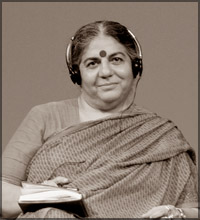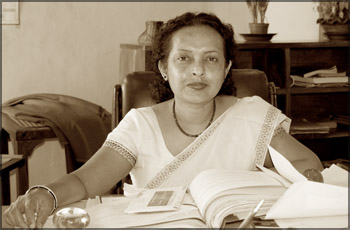Women- part and parcel of nature?
Ecofeminism - the debate is on:
by Samangie WETTIMUNY
[email protected]
Women are known for their ability to endure, so is the mother nature.
This striking similarity has always been providing inspiration for great
writers, poets, artists and dramatists alike. Anyway the ones who say
“If you love nature, you love women” may sometimes not have even an iota
of knowledge about the great worldwide movements which observe a
relationship between the oppression of women and the degradation of
nature!

It was mainly from the early 1940’s that environmentalists and
sociologists started to draw a relationship between environment and
society. In the early 1970s concepts like deep ecology emerged which
consider humankind as an integral part of the environment. Areas like
deep ecology, political ecology too developed as human beings started
identifying the impact of the environmental change on society and how we
could adapt to the new surrounding. Anyway the focus of environmental
sociology is largely on the inter relationship between society and the
environment-not that the environment has an impact on society, but that
society makes a huge impact on environment and we experience the
results. Ecofeminism too is a movement which links human beings with
nature; in fact it tries to unite environmentalism and feminism linking
deep ecology and feminism. “Ecofeminists argue that a relationship
exists between the oppression of women and the degradation of nature,
and explore the Intersectionality between sexism, the domination of
nature, racism, speciesism, and other characteristics of social
inequality.
Dr. Subhangi Herath, Head of the Department of Sociology, University
of Colombo says that though now there is a considerable amount of
literature on ecofeminism, the ideas of Indian national physicist,
environmental activist, and author Vandana Shiva marked the beginning of
the movement.
“Vandana Shiva’s argument was that women are part and parcel of
environment. You can’t talk of women as a separate entity from the
environment because women are part of nature.Not that men are not a part
of nature. They are also a part of nature. But the life of women is much
more naturally constructed and bound with what is natural. As she says
if we look at the whole construction of world, men are mostly involved
in the ‘productive sphere’, and women are mostly involved in the
‘reproductive sphere’. That is where the segregation is.”
Vandana Shiva’s ideas
As Dr. Herath further elaborated: “Men are involved in production,
but women are involved in reproduction. What Shiva meant was not only
the human reproduction, but the reproduction of environment as well.The
major difference between these two processes is that production uses
resources that are there. But reproduction process recreates resources
that are there. So it is not only a reproduction of labour, species ,
but a reproduction of everything else.”
|

Vandana Shiva |
Vandana Shiva not only examined the ways in which women are involved
in the reproduction of nature, but also how they are affected by the
threats to the environment. Because of the close relationship women have
with the environment they are the people who would feel it most.who
would face most of the negative outcomes. To prove her point Shiva
brought out examples of environmental movements such as Chipko movement
and Narmada movement which were launched with the initiative of women.
Bina Agarwal
Though Indian economist, Prof.Bina Agarwal was critical of Vandana
Shiva’s ideas; she too contributed a lot to ecofeminism. In fact Bina’s
ideas are more on line with most of the British environmentalists.
“What Bina Agarwal said was locating women in the reproductive
sphere, is exactly what feminist scholars did not want to do. What
feminist scholars said was women in their lives have more doubts of
reproductive sphere,and they are capable of moving out of reproductive
sphere if they wish.
Also they are capable of involving themselves in productive sphere.
So locating them in the reproductive sphere means we are bringing them
back to the primitive age. When we link women with nature, it looks as
if women are natural, and they live in their natural form . So it seems
that then it is difficult to move them out of the reproduction sphere.”
|

Bina Agarwal |
As Dr. Herath says most of the ecofeminists like Naila Kabeer,
Melissa Leitch belong to the same school of thought of Bina Agarwal. “In
fact what they said was both men and women are involved in reproduction
as well as in production. Since women are capable of doing that, it is
not necessary to revert the role of women back to the domestic and
reproduction spheres combining them with nature. Reverting their roles
means moving them back to a very local and primary set of relations.
Women’s role is equally important in the production process.
Also the scholars of this school of thought do not underestimate
women’s role in the reproduction sphere. Women’s role in reproduction is
important; their link with nature is also important.
But women are equally important in the production sphere as well. In
rural (traditional) societies women have always been participating in
the production process on par with men. So if men are responsible for
damaging the environment, so are women. “So according to the second
school of thought, women are being pushed into the reproduction process
by society, not that they got involved in it willingly or they were born
for that. That is actually the root cause of gender disparity. There
they face the repercussions of environmental destruction. So it is
against their will that they are being pushed into reap the negative
consequences of environmental destruction.
|

Naila Kabeer |
In order to identify how the consequences of environmental
destruction have a negative impact on women, we have to examine the ways
in which women were being pushed into these areas. Professor Melissa
Leitch has written a lot about women and war. In her writings Naila
Kabeer has mainly focused on rural development in the third world and
how women have been marginalised in the development processes. Since (in
the third world) development mainly go hand in hand with environmental
destruction, it is obvious that it is a part of the modern development.
So when women are supposed to live more on natural resources than
men, when their life is based more on nature, then any type of
destruction caused to nature would definitely affect women. It is not
that women are natural and they lead a life that is natural, but women
are pushed to that level and because of that they are the people who
incur losses as a result of environmental degradation.Talking about
ecofeminist literature written on war and women, Dr. Herath, pointed out
that some of the early writings saw war as a cause of natural
destruction of the environment. It is a field where mainly men are
involved. It is women who have to handle all household matters such as
feeding children,taking care of family etc. So when the environment and
natural resources suffer damage due to war, women have to bear the
larger burden because it is their survival that is being threatened.
But the new writers on the subject who emerged in the early 1990s,
hold the view that it is not just a question of war or of natural
resources.It could be in both ways. Sometimes in certain countries (in
India and in African countries), it is the environmental destruction
that caused war.
Scarcity of natural resources causes poverty and that itself becomes
a factor that leads to war.
|

Dr. Subhangi Herath, Head , Department of Sociology,
University of Colombo Pic : Kavindra Perera |
The decline of natural resource base in a country would compel people
to fight with one another, in order to reap the benefits of the
remaining natural resources.
“ If we examine the root causes of the most of the conflicts in the
world , we can see that such conflicts always have some kind of a link
with the natural resource bases. “If we say land. What is land? A
natural resource.” says Dr. Herath.
“But we have to see whether women had entitlements in natural
resources.
In most of the traditional societies women had some kind of an
entitlement to land - a natural resource. So they were not separated
from the ownership of resources in many of the traditional societies.
With social changes (wars, development projects),women were gradually
removed from their entitlements. If there is a war, if there is a
degradation of natural resources, it is what women initially owned that
they lost. It was what they lived on that they lost. As prof. Leitch and
Nailar Kabeer say since they are more close to nature , they feel the
loss more.
“Whatever the ideas that were later added to the concept, Vandana
Shiva’s initial explanation is still important “ says Dr.Hearth who also
agrees with the views of Naila Kabeer and Prof.Melissa Leitch. “As
Vandana Shiva quite correctly said we simply can’t say that the
relationship men have with the environment is similar to that of women
have with the environment. Those are two different relationships.
As a result if there is a negative environmental impact on society
due to the environmental destruction that impact would also be felt
differently by men and women. “The later theories are important to
examine what this relationship is as we can’t simply say that women are
more close to nature without substantial proof”.

Nature may be important to them because of the position they have
been put into. As I mentioned earlier movements like Chipko movement,
Narmada movement were led by women. In Chipko movement women went and
hugged the trees and did not let people to cut the trees.They knew that
their survival will be threatened. In India when it was proposed to
build a dam across Narmada river, the same thing happened. Vandana Shiva
described these two as occasions where women genuinely felt their link
to the natural environment. They wanted to safeguard the natural
environment in which they are living. But there is something more into
it. True that women felt it because they depend on it.
But is it because they are more close to nature? That’s the question.
They are just involved in reproduction, reproduction of nature. No,
because they have been pushed into it.
“It is women who felt the negative impacts of tsunami most. There
were more deaths of women and children than of men. That is one thing.
The second thing was though it was the resources of men (Boats, fishing
equipment etc) that were largely destroyed, they could always restart
their lives when necessary equipment were provided. But women who have
to carry on the struggle of the household. Women lost their husbands,
children, property. It is difficult for them to restart life. “Society
thinks that restarting life is solely women’s responsibility. When men
are affected by some disaster their lethargy to restart life will always
be justified. But none will justify the lethargic attitude of women. “So
they can’t simply sit and wait. They have to struggle and get out of
it.” explains Dr. Subhangi.

“Women have to bear all these responsibilities because of the
separate gender roles for women and men. “
“As I said earlier the attitude society has towards nature should be
thoroughly examined. “ Because of the different roles they play in
society they have different relationships with the environment.”How
these relationships are created is worthy of study. Is it because they
give birth to children they are more close to nature? No. Both men and
women are involved in the reproduction process. It is society which
ascribe different roles to men and women. It is through the
socialisation process that they gradually learn what their respective
gender roles are. Women and men become separated from each other and
they are given two different roles and their relationship with the
environment too becomes different. So women have been made to become
more closer to environment and therefore women feel more than men feel
when the environment gets destroyed.
The other thing worthy of study is what makes women’s role towards
environment more a friendly one than that of men. (But this is not the
case always, when women work in the industrial sector they too
contribute a lot to the destruction). Anyway it has constantly been
emphasised that women maintain a friendly relationship with nature. So
scholars have highlighted the importance of building up environmental
conservation strategies centred around women because they have become
the protectors of environment in many of the countries,eg. in Latin
America, Africa, and in India. They can play a main role with regard to
this. “But unfortunately in Sri Lanka we don’t see women taking a
leading role in this regard. In Sri Lanka it is mainly men and monks who
played a leading role in movements that arose opposing the construction
of the Kandalama hotel or Noroccholai coal power plant.
Women’s role is not significant in our country though they have
understood the importance of preserving environment. Anyway it is women
who face most of the repercussions. In traditional setup women had been
involved in protecting environment than today.
Anyway Dr. Herath was optimistic of certain eco friendly movements
developing in Sri Lanka, but noted that it is better if women could
participate more in protecting theenvironment as it is where everyone
lives . |
